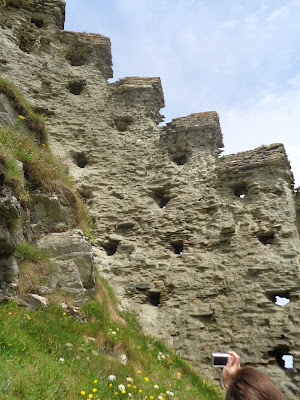 |
| Arthur staking out his claim? |
King Arthur and the Knights of the Round Table - fact or fantasy? Even today no one really seems to know for certain. Some believe he may have been a mythological figure based on a military leader who helped stave off a Saxon invasion in the 5th-6th centuries, but given this was during the Dark Ages, a time for which there are few historical records compared to other eras, it is likely there will always be room for debate on the subject!
Likewise, with Camelot, the supposed court of King Arthur. There have been numerous claims over the years as to its whereabouts, the latest being in 2016 when a
retired professor claimed that the site was outside of Huddersfield, West Yorkshire. If that's true, sadly, Camelot is now buried under a motorway.
There is one place that has become associated with King Arthur, the existence of which cannot be denied, and that is
Tintagel in Cornwall. Set on soaring cliffs on the northern coast, Tintagel not only offers a pretty village but also the ruins of a castle built by Richard, Earl of Cornwall in the 13th century and the remains of a settlement which is believed to date back to the Dark Ages.
In 1136 a Welsh cleric and British historiographer, Geoffrey of Monmouth, penned
The History of the Kings of Britain, a work which is now labeled as pseudohistory (who knew such a genre existed?) but is considered to have been the initial impetus behind the modern day legend of King Arthur. Geoffrey's claim that Arthur was magically conceived at Tintagel in Cornwall brought international literary fame to Tintagel which has endured ever since and apparently inspired the Earl of Cornwall to build his castle there.
I'd always associated
Tintagel Castle with King Arthur so it was a little disappointing to learn that the castle was built several hundred years too late to have any connections to the legend, but the village and ruins are in such a spectacular setting it was still well worth a visit.
 |
| view of Merlin's cave from the headland |
It definitely pays to be fit if you are going to visit as a deep chasm separates the gatehouse and main courtyards from the headland where the rest of the castle lay. Nowadays, a long staircase connects the two.
 |
| stairway to mainland courtyards |
Substantial portions of the castle still remain:
 |
| The gatehouse |
 |
| the outer walls |
 |
| The mainland courtyard |
 |
Castle chapel ruins
|
It is believed that back in the Dark Ages, the area was part of the Celtic Kingdom of Dumnonia. (Sounds like something out of Game of Thrones to me!)
Recent excavations during an on-going five-year English Heritage project have revealed the existence of substantial settlements, together with fragments of luxury goods originating from Mediterranean countries, which suggest Tintagel was a major trading post at the time. Interestingly,
evidence of a Dark Ages Royal Palace has also been found, which could spark further speculation on whether there is more truth to Geoffrey of Monmouth's claims about Arthur and his birthplace than first thought.
Mel writes contemporary fiction with a twist of mystery and suspense. For more information about her books visit her website, or sign up for her newsletter at http://bit.ly/melparishnews








No comments:
Post a Comment